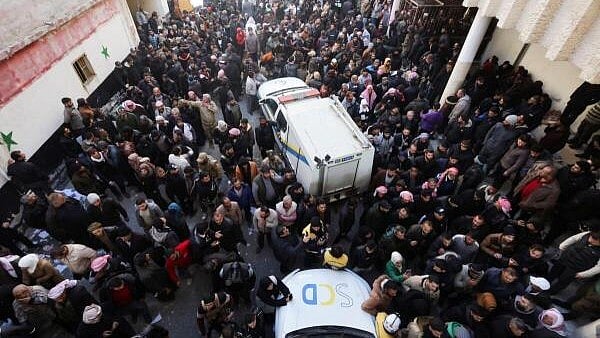
People gather as members of the Syrian civil defence group, known as the White Helmets, search for prisoners underground at Sednaya prison, after rebels seized the capital and announced that they have ousted President Bashar al-Assad in Sednaya, Syria.
Credit: Reuters Photo
Damascus: Crowds descended on a prison on the outskirts of Damascus, the Syrian capital, on Monday, desperate to learn the fate of friends and relatives detained at a place that symbolized terror and death under the regime of President Bashar Assad.
Some hailed taxis or waited for buses from the city to the prison, Sednaya, which opened over the weekend as Assad fell. Others packed into cars, inching through traffic. Many appeared conflicted by hope and dread amid the euphoria that has gripped Damascus since Assad fled to Russia.
Track latest updates on Syrian crisis here.
“Seizing the city is a joy — we are joyous,” said one rebel fighter, Mohammad Bakir, who sat in the back of a mud-caked car en route to the prison, his rifle tucked between his knees. He said he had not heard from his mother, brother and cousin since they disappeared in 2012 after they protested against the government and were presumably detained.
“But the real victory will be when I find my family,” Bakir, 42, said above the din of car horns.
Prisons were central to Assad’s ability to crush the civilian uprising that began in 2011 and the rebellion that followed. He set up an industrial-scale system of arbitrary arrests and torture prisons, according to reports by human rights groups.
More than 130,000 people were subjected to arbitrary arrest and detention by the government, according to a report in August by the Syrian Network for Human Rights, a nonprofit, which began its count when the conflict started in 2011. The network said more than 15,000 people had died “due to torture” by government forces from 2011 to July this year.
The Syrian Observatory for Human Rights, a separate organization that is based in Britain and that documents abuses in Syria, has estimated that more than 30,000 detainees were killed in Sednaya alone.
A crucial element of the pall that the prisons cast over the country was secrecy. People were swallowed up by the system, and families often struggled to discover whether their relatives had even been detained, much less to determine their fate. As a result, the opening of the prisons became an imperative for the rebels.
Videos sent to The New York Times by a group of doctors visiting Sednaya appeared to show the dire conditions inside. The footage was shared by the Independent Doctors Association, a group providing humanitarian and medical assistance in Syria.
Numbered cells, each of which appear to have held a dozen or more people, are seen littered with debris, clothing and personal belongings. Journalists, armed fighters and civilians, including children, roam the prison. Several men scrape at the concrete and grates along a wall in an apparent attempt to reach hidden cells.
In the northwestern city of Aleppo, dozens of families gathered at a traffic circle, hoping for the arrival of loved ones who had been detained. The spot was known during the war as the Death Roundabout because it was a regular target of government airstrikes.
Some were certain that their family members were alive and would arrive soon. Others had no information, only hope.
A vehicle dropped off one former prisoner from Sednaya, his face gaunt and his legs and body weakened by years of detention. Two relatives helped him stand. A small band of musicians beat drums to celebrate his survival.
The man was soon thronged by people holding their cellphones up to his face. They were showing him photographs of detainees, hoping he might have news.